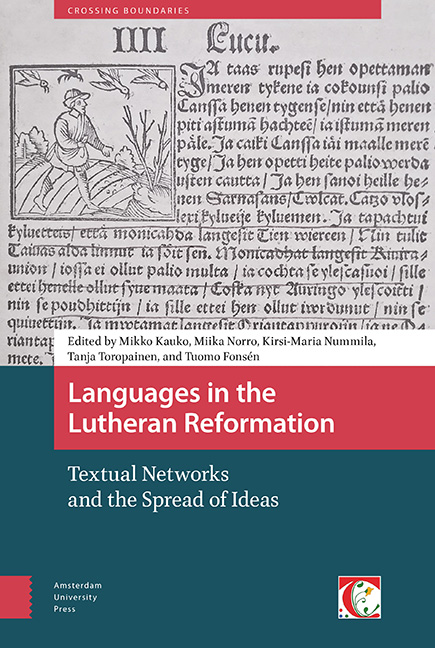Book contents
- Frontmatter
- Contents
- List of Figures and Tables
- Preface
- Introduction
- Part I The Reception of Luther's Ideas and their Influence for the Development of Written Languages
- Part II Effects of Bible Translations on the Evolution of Written Language
- Part III Reuse of (Catholic) Texts after the Reformation
- Part IV Language Contacts and Loanwords
- Index
Introduction
Published online by Cambridge University Press: 21 November 2020
- Frontmatter
- Contents
- List of Figures and Tables
- Preface
- Introduction
- Part I The Reception of Luther's Ideas and their Influence for the Development of Written Languages
- Part II Effects of Bible Translations on the Evolution of Written Language
- Part III Reuse of (Catholic) Texts after the Reformation
- Part IV Language Contacts and Loanwords
- Index
Summary
The inspiration for writing and publishing the current work, Languages in the Lutheran Reformation: Textual Networks and the Spread of Ideas, arose from the 500th anniversary of the Lutheran Reformation. The Reformation was an extremely powerful influence for many of the languages and the literalization processes that took place in the Baltic Sea region. Consequently, the language forms and texts written during the transition from the Middle Ages to the early modern period have been of interest to linguists and philologists for decades. The ideas of the Lutheran Reformation were spread, above all, by means of texts and as a result of translation into vernaculars. The circulation of Reformation ideas could be seen as textual networks that extended to the Baltic Sea region and partly beyond, serving to unite the Lutheran world. In this volume, the central theme is not specific languages and their development but the interrelationships between languages and the ways in which different linguistic and literary influences have been passed from one language to another. The current work offers the perspectives of individual languages on the common cultural phenomenon of the Reformation, which itself affected different languages and in many ways served to link them.
The chapters in this volume focus on northern Europe in the 16th to 17th centuries, more specifically on the Baltic Sea region and its sphere of influence. As is still the case today, many different languages were spoken in the region at that time. They include representatives of many language groups – Germanic, Slavic, Baltic, and Baltic-Finnic languages. This work deals with a large number of languages, and all the language groups are represented, including German (Low and High German), Swedish, Danish, Norwegian, Icelandic, Dutch, Finnish, Estonian, Latvian, Lithuanian, Polish, Czech, and English. During the period under study, it was typical that many languages were spoken in the same administrative area. Also, individual speakers were quite often multilingual, especially in towns. Everyday contacts between the languages were a significant factor in facilitating the relatively rapid spread of influences from one language to another.
The 16th century was an eventful period in northern Europe, and it is impossible to give more than a brief account of the events that were most significant historically.
- Type
- Chapter
- Information
- Languages in the Lutheran ReformationTextual Networks and the Spread of Ideas, pp. 11 - 30Publisher: Amsterdam University PressPrint publication year: 2019
- 1
- Cited by



